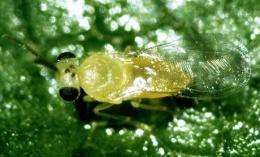Tiny parasitoid wasp Encarsia aleurochitonis is only 1mm long and was recently discovered in the UK by Museum scientist Andrew Polaszek
(PhysOrg.com) -- A new species of parasitoid wasp that feeds on a common whitefly pest has been discovered in the UK by a Natural History Museum scientist.
Museum wasp expert Dr Andrew Polaszek found the tiny 1-mm-long insect, Encarsia aleurochitonis, near his home in Kent and spotted it after it hatched from its host, an adult whitefly.
Although known in mainland Europe, this is the first time the wasp has been recorded in the UK. However, it is probably native to the UK and has just been missed due to its tiny size.
Encarsia aleurochitonis is harmless to humans and does not sting. It is a parasitoid, which is an organism that kills its host as it develops compared to parasites that rarely kill their host.
The adult lays its eggs in the bodies of living whiteflies. The eggs hatch inside the whitefly and the larvae eat the host from within. It then pupates and finally emerges from the dead whitefly as an adult wasp.
Andrew made the discovery while collecting samples of whitefly for his parasitoid wasp research. A few days later, he saw one of the tiny creatures crawl out from a dead whitefly.
‘Knowing this particular group in detail after more than 20 years of study,’ says Andrew, ‘I immediately recognised it as a species that is know from continental Europe, but never before recorded from Britain.’
Andrew compared the new wasp with those in the Museum’s huge 3.5 million wasp specimen collection. He was then able to confirm the identification.
There is an impressive 7,500 species of wasp in the UK. Of these, 6000 are parasitoid and most of these are parasitoids of other insects such as moths and butterflies - especially their eggs and caterpillars - flies, beetles, greenflies, whiteflies, scale insects and other wasps. There is even a wasp group called hyperparasitoids that are parasitoids of parasitoids!
The smallest parasitic wasp is less than 1/5th of a millimetre (0.17 mm) - this species also occurs in UK. The largest parasitoids may be 10cm or more in length.
Parasitoid wasps perform vital ‘ecosystem services’- they control species that are often pests of horticulture and other forms of agriculture, such as the whitefly.
This is an example of biological control and, importantly, they control one or a few species only, without affecting other wildlife.
Andrew explains, ‘The reason they are often so successful is because they are host-specific - developing on one or a handful of related species. This is in stark contrast to notorious examples of biological control gone wrong, as is the case with the cane toad introduced to Australia.’
Parasitic wasps are such good biological controls that many have been successfully produced and distributed commercially for several decades. Encarsia formosa - a close relative of Encarsia aleurochitonis - is the best-known example.
Provided by American Museum of Natural History (news : web)





















